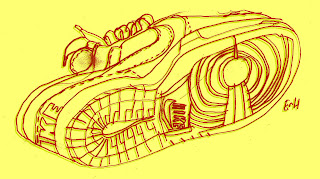I did some art yesterday for the
New York Times op-ed page. The topic, while not as important as the sexual foolishness of a congressman, is pretty important: congressional gridlock, two political parties unable to compromise. Not a sexy issue. Given such a small space the key is to convey the essence in as few lines as possible, so I drew two angry men face to face. I drew them several ways.



To underline the nature of the confrontation I thought of overlaying the word NO in a gray tone.



I liked the look, but wondered whether it added nuance or unhelpful complexity. Did it distract? The point of this small illustration in the letters column isn't to make readers stop and make sense of it but to make them read the adjacent letters. We left the word NO out.
The word NO also conveyed a false equivalency. It implied that both parties were saying NO with equal force, which I don't think is true. One of the two parties has shown a greater flexibility over the past decade. Yes, they are both angry, but I think the one party (the one on the left) is angry because it's tired of always giving in.
I'm saying this very carefully because the illustrator's job isn't to shape the meaning but to convey it, which is also the job of journalists. I think False Equivalency is a big problem. If there are two sides to an argument a journalist is supposed to impart both of them in a fair manner. This sometimes puts the writer in the uncomfortable position of treating foolishness and intelligence the same, or fairness and bigotry, or greed and generosity. If you equate moderation and extremism equally and without any negative weight on one side, after a while the more extreme position is rewarded and encouraged.
Is it a cop-out for an artist to go only as far as the text goes and no further? Or is that his job? A lot of thought and worry goes into a small drawing.












